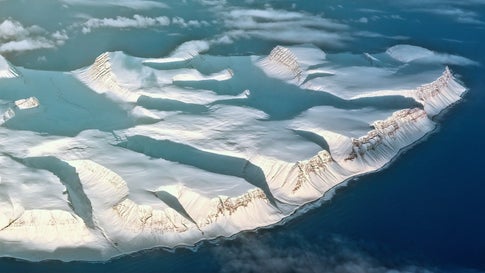Plastic snow falls from the sky
北極已經下起了“塑料雪”?
When you think of the Arctic, you imagine an icy land of pure white snow. Others imagine it as the last really clean place left on Earth. We have polluted the deepest oceans with plastic trash, and now, CNN says, "It's the Arctic's turn."
當想到北極,你會想象到一片被白雪所覆蓋的冰原。還有一些人會認為那是地球上最后一塊凈土。我們的塑料垃圾已經污染了海洋最深處,而如今,據美國有線電視新聞網報道,“這次輪到北極了。”
German scientists have recently found microplastics in Arctic snow, the Associated Press reported. Microplastics are pieces of plastic smaller than 5 millimeters. Sadly, the scientists found 1,800 pieces of microplastic per liter of snow.
據美聯社報道,德國科學家近期在北極的積雪中發現了微塑料。微塑料是指小于5毫米的塑料顆粒。令人難過的是,科學家們發現每升雪中含有1800個微塑料顆粒。
How is plastic pollution reaching the Arctic? According to scientists, "It's readily apparent that the majority of the microplastic in the snow comes from the air." They fall off of plastic objects and are moved by the wind, just like dust. They mix with ice in the air and fall to the ground as snow. Finding these plastics in Arctic snow means that we may breathe them in. An even higher amount of microplastic was found in the snow around cities.
這些塑料污染物是如何到達北極的呢?科學家們認為,“積雪中的大部分微塑料明顯來自于大氣。”這些顆粒從塑料物體上脫落,和塵埃一樣隨風飄到各處。它們與大氣中的冰晶結合,通過降雪落到地面上。在北極的積雪中發現這些塑料意味著我們或許會將其吸入體內。城市周邊的積雪中還發現了更多微塑料。
The high concentrations found in snow samples suggest microplastics, which contain rubber or chemicals used in synthetic fabrics, may cause significant air pollution.
微塑料中含有用于合成纖維的橡膠和化學物質,而積雪樣本中發現了高濃度微塑料意味著這或許會導致嚴重的空氣污染。

Are they bad for us? Scientists cannot answer this question for now, according to the World Health Organization. We do know that our bodies cannot take in "large" pieces of microplastics. However, if the plastics are small enough, they can find ways into our bodies and stay there for a long time, which can be bad for our health. What's more, earlier studies have shown that microplastics may contribute to lung cancer risk, heightening the need to further assess the risks of taking them in, the study said.
這些微塑料對人體有害嗎?世界衛生組織認為,科學家們目前還無法回答這個問題。我們都知道身體無法吸收“大顆粒”的微塑料。但如果這些塑料顆粒足夠微小的話,它們就能夠進入人體,并長期存在于人體內,對健康產生不利影響。此外,先前的研究還表明,微塑料或許會增加肺部癌變的風險,該研究顯示,需要進一步評估吸入這些微塑料的風險。
Microplastics have also been found in rivers and oceans around the world. Previous research has found that they flow over long distances and into our oceans, damaging ecosystems along the way. They start in our wastewater, when we wash clothes with plastic fibers. The wastewater then flows into rivers and out to sea, where they are eaten by sea animals. If people then eat these animals, it means that we're eating the plastic as well.
全球的河流和海洋中也發現了微塑料。先前的研究發現,它們漂了很遠的距離進入海洋,所到之處破壞生態系統。當我們洗滌的衣服中含有塑料纖維時,微塑料便會殘留在污水中。這些污水之后流入江河和海洋,并被海洋生物攝入。如果人們食用了這些海洋生物,也就意味著我們也攝入了塑料。












